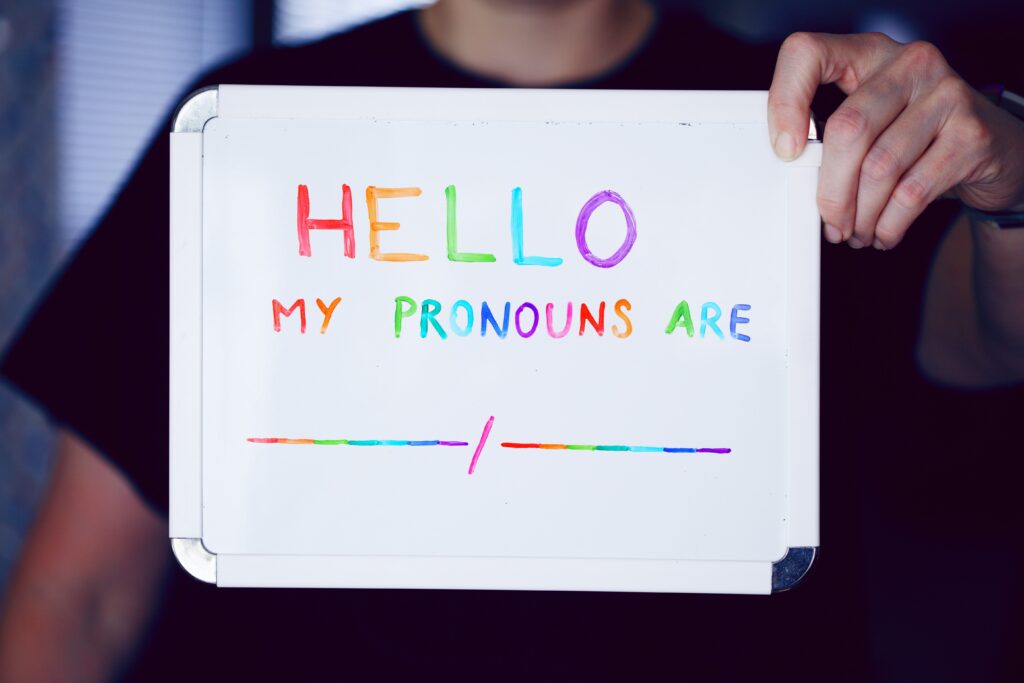
Text A2
English
Gender-neutral pronouns are words we use to talk about people without saying if they are male or female. Some common gender-neutral pronouns are „they,” „them,” and „their.” Using these words can make everyone feel respected and included. It is important to ask people which pronouns they like. This helps to show respect and understanding.
Polish
Zaimki neutralne płciowo to słowa, których używamy do mówienia o ludziach bez określania, czy są mężczyznami, czy kobietami. Niektóre popularne zaimki neutralne płciowo to „oni,” „im,” i „ich.” Używanie tych słów może sprawić, że każdy poczuje się szanowany i włączony. Ważne jest, aby zapytać ludzi, które zaimki lubią. To pomaga okazać szacunek i zrozumienie.
Text B2
English
Gender-neutral pronouns are linguistic tools that help us refer to people without assuming their gender. Examples include „they,” „them,” „their,” and less common ones like „ze,” „hir,” and „xe.” These pronouns are essential in fostering an inclusive environment. It’s courteous to ask individuals their preferred pronouns to avoid misgendering them. Many people use gender-neutral pronouns to respect non-binary, genderqueer, or gender-nonconforming identities. Understanding and using these pronouns correctly is a sign of respect and inclusivity.
Polish
Zaimki neutralne płciowo to narzędzia językowe, które pomagają nam odnosić się do ludzi bez zakładania ich płci. Przykłady to „oni,” „im,” „ich,” a także mniej powszechne, jak „ze,” „hir,” i „xe.” Te zaimki są niezbędne do tworzenia środowiska włączającego. Grzecznością jest zapytać o preferowane zaimki, aby uniknąć błędnego określenia płci. Wiele osób używa zaimków neutralnych płciowo, aby szanować tożsamości niebinarne, genderqueer lub niezgodne z płcią. Zrozumienie i prawidłowe używanie tych zaimków jest oznaką szacunku i włączania.
Text C2
English
Gender-neutral pronouns have become a crucial aspect of contemporary linguistic practices aimed at inclusivity and respect for gender diversity. These pronouns, such as „they,” „them,” and „their,” along with neopronouns like „ze,” „hir,” and „xe,” allow for communication that does not presuppose a binary gender framework. The adoption of gender-neutral pronouns acknowledges and respects the identities of non-binary, genderqueer, and other gender non-conforming individuals. By asking and using the correct pronouns, we can avoid misgendering, which can be a source of distress and marginalization. Therefore, the integration of gender-neutral pronouns in everyday language is a step towards a more inclusive and respectful society.
Polish
Zaimki neutralne płciowo stały się kluczowym aspektem współczesnych praktyk językowych, mających na celu włączenie i szacunek dla różnorodności płciowej. Te zaimki, takie jak „oni,” „im,” „ich,” oraz neopronomy, takie jak „ze,” „hir,” i „xe,” umożliwiają komunikację, która nie zakłada binarnego systemu płci. Przyjęcie zaimków neutralnych płciowo uznaje i szanuje tożsamości osób niebinarnych, genderqueer i innych osób niezgodnych z tradycyjnymi normami płci. Pytanie o preferowane zaimki i ich używanie pozwala unikać błędnego określenia płci, co może być źródłem stresu i marginalizacji. Dlatego integracja zaimków neutralnych płciowo w codziennym języku jest krokiem w stronę bardziej włączającego i szanującego społeczeństwa.
Vocabulary Exercise
A2 Level
- Gender-neutral pronouns are words we use to talk about people without saying if they are m_ _e or female.
- Some common gender-neutral pronouns are „they,” „them,” and „their.”
- Using these words can make everyone feel respected and i_ _ _ _ded.
- It is important to ask people which pronouns they l_ _e.
- This helps to show r_ _ _ect and understanding.
B2 Level
- Gender-neutral pronouns are linguistic tools that help us refer to people without assuming their g_ _der.
- Examples include „they,” „them,” „their,” and less common ones like „ze,” „hir,” and „xe.”
- These pronouns are essential in fostering an i_ _ _ _sive environment.
- It’s courteous to ask individuals their preferred pronouns to avoid misgendering t_ _m.
- Many people use gender-neutral pronouns to respect non-binary, genderqueer, or gender-nonconforming i_ _ _tities.
- Understanding and using these pronouns correctly is a sign of respect and inclusivity.
C2 Level
- Gender-neutral pronouns have become a crucial aspect of contemporary linguistic practices aimed at inclusivity and respect for gender d_ _ersity.
- These pronouns, such as „they,” „them,” and „their,” along with neopronouns like „ze,” „hir,” and „xe,” allow for communication that does not presuppose a b_ _ary gender framework.
- The adoption of gender-neutral pronouns acknowledges and respects the identities of non-binary, genderqueer, and other gender non-conforming individuals.
- By asking and using the correct pronouns, we can avoid misgendering, which can be a source of distress and m_ _ _inalization.
- Therefore, the integration of gender-neutral pronouns in everyday language is a step towards a more inclusive and r_ _pectful society.
Vocabulary Exercise Answers
A2 Level
- male
- included
- like
- respect
B2 Level
- gender
- inclusive
- them
- identities
C2 Level
- diversity
- binary
- marginalization
- respectful
